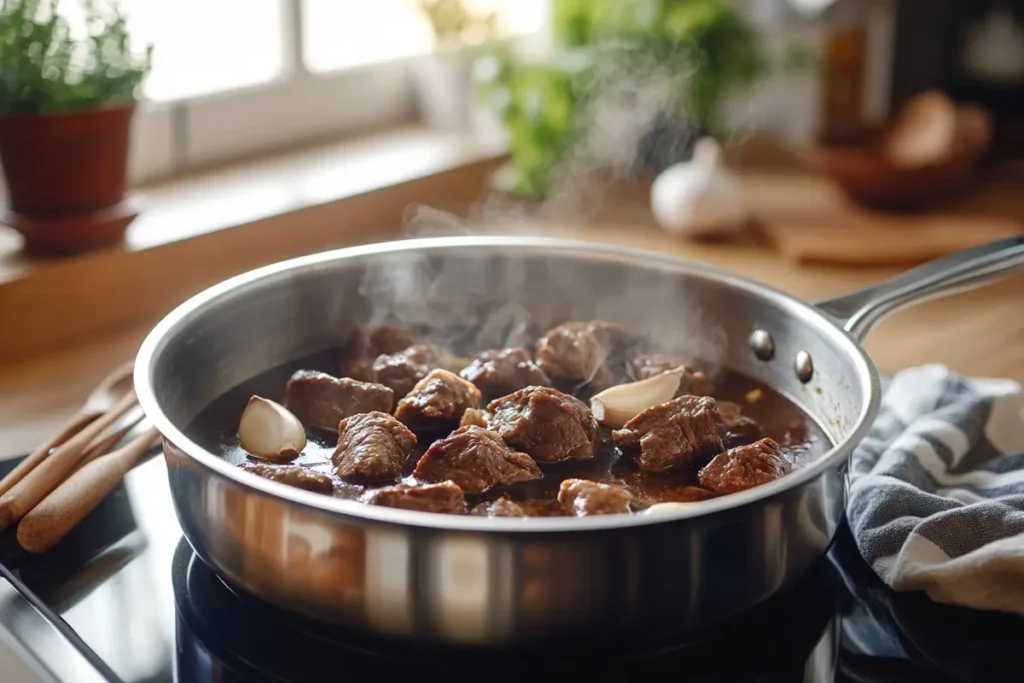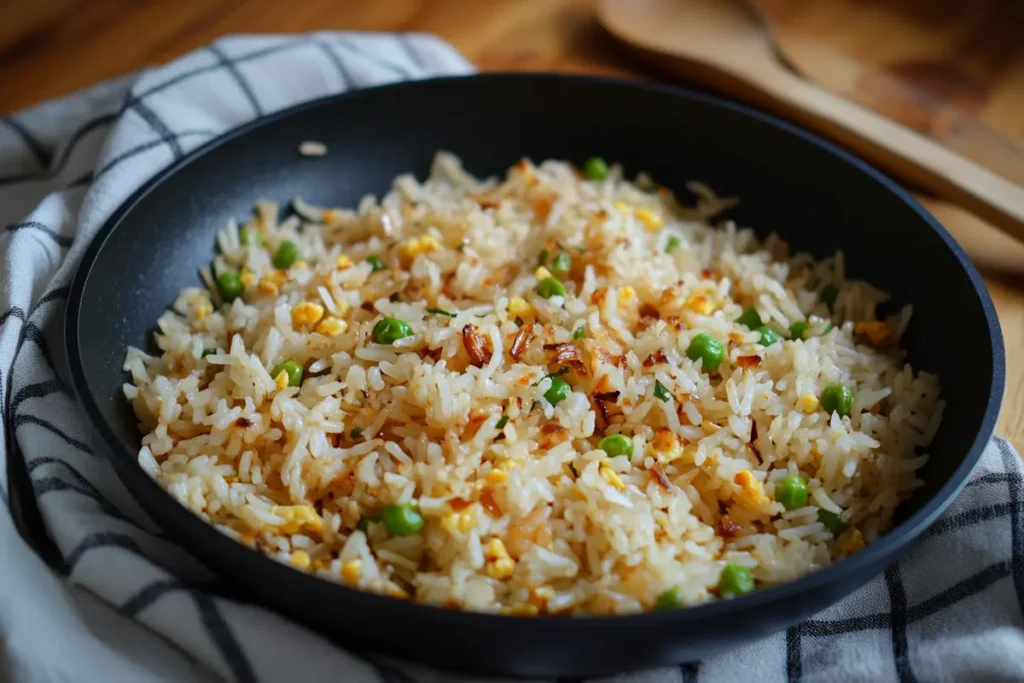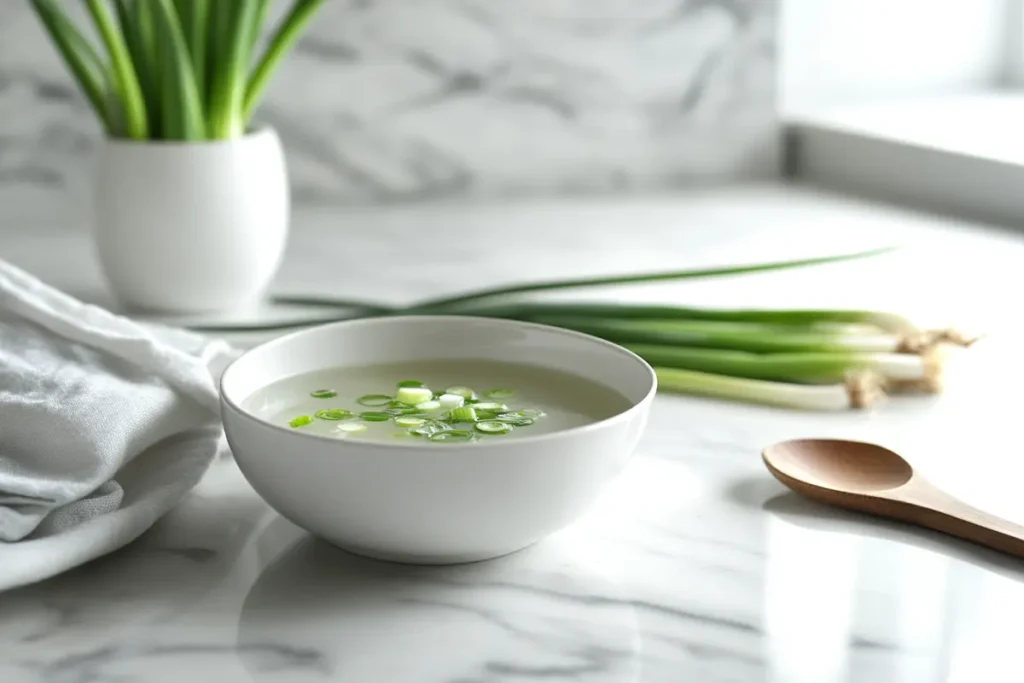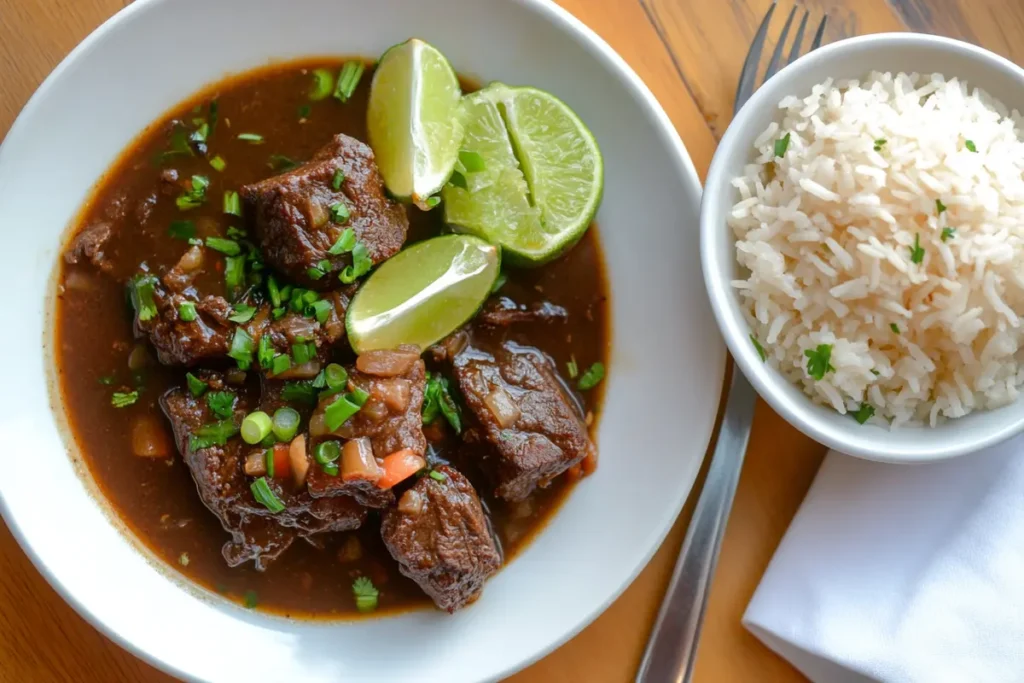Introduction and Preparation
A good beef pares recipe starts with understanding what makes this dish stand out. The flavorful beef stew is simmered in soy sauce, star anise, sugar, and aromatics until it’s fork-tender and coated in a glossy sauce. The dish’s appeal lies not just in its taste, but also in its versatility—it’s the ultimate comfort food that’s both homey and rich.
But here’s the twist—beef pares served alongside fried garlic rice and a bowl of clear beef broth, creating a deliciously balanced meal that hits every note. In Filipino homes and eateries, beef pares is a staple on menus, especially as a breakfast or late-night snack.
Ingredients Needed for Beef Pares
When it comes to cooking beef pares, the magic lies in fresh, quality ingredients. Here’s what you’ll need:
Ingredients For the Beef Stew:
- 2 lbs of beef brisket or short ribs (for that perfect tenderness)
- 4 tablespoons soy sauce (preferably dark soy sauce for richness)
- 1 tablespoon oyster sauce (optional but enhances depth)
- 2 tablespoons brown sugar (or adjust to your taste)
- 1 large onion, chopped
- 6 cloves garlic, minced
- 2-inch piece of ginger, sliced
- 2 pieces of star anise
- 2 cups water or beef broth (homemade broth adds amazing flavor)
For Garlic Fried Rice (Sinangag):
- 4 cups of day-old rice (cold rice works best for frying)
- 6 cloves of garlic, minced finely
- 2 tablespoons cooking oil
- A pinch of salt
For the Clear Beef Broth:
- 4 cups beef broth (or water boiled with beef bones for a richer taste)
- A dash of pepper
- 1 green onion, chopped (for garnish)
Optional garnishes: chopped scallions, fried garlic, and lime for an extra citrusy kick.
Choosing the Right Cut of Beef
When making beef pares, choosing the right cut of beef can make or break the dish. You want something that becomes tender without falling apart too easily.
- Beef Brisket: The go-to choice for traditional beef pares. Its marbled fat adds so much flavor as it melts during cooking.
- Short Ribs: These add a beautiful richness to the stew—perfect for special occasions.
- Chuck Roast: A more affordable option that’s still full of flavor.
When buying beef, look for well-marbled pieces to ensure the stew doesn’t dry out. Avoid lean cuts like sirloin—they won’t give you that melt-in-your-mouth effect you’re looking for.
Preparing the Beef: Marination and Tenderization
The secret to a great beef pares recipe is in the prep. A good marinade infuses the beef with flavor and helps tenderize it, making each bite irresistible.
Marination Steps:
- Combine the flavors: In a bowl, mix soy sauce, oyster sauce, garlic, and ginger. Add in the star anise to give it that distinct aroma.
- Coat the beef: Toss the beef pieces in the marinade until they’re evenly coated. Let it sit for at least an hour—though overnight is even better for deeper flavor absorption.
- Tenderizing Tip: If you want that “fall-apart” texture, consider using a meat tenderizer or slow-cooking the beef over a low flame.
Marination is where the magic begins. Don’t skip this step—your taste buds will thank you later!
Cooking Steps for Beef Pares Components
Cooking the Beef Stew

Now that your beef is marinated and bursting with flavor, it’s time to turn that tender meat into a rich, savory stew. This part will fill your kitchen with a mouth-watering aroma that’ll make waiting hard—but hang tight, it’s worth it!
Step-by-Step Instructions:
- Sauté the Aromatics:
Heat oil in a deep pan over medium heat. Add the chopped onion and cook until it’s translucent. Toss in the minced garlic and ginger, and stir until fragrant—your kitchen should smell heavenly by now! - Add the Beef:
Drain the beef pieces (reserve the marinade) and sear them in the pan until browned on all sides. Searing locks in the juices, giving the beef that irresistible crust. - Pour in the Marinade:
Pour the reserved marinade into the pan, ensuring all those rich flavors are fully utilized. Stir in the star anise, and watch the sauce bubble as it thickens slightly. - Simmer and Tenderize:
Add 2 cups of water or beef broth to the pan and bring it to a boil. Once boiling, reduce the heat to low, cover with a lid, and let it simmer for 1.5 to 2 hours until the beef becomes fork-tender. Check occasionally to stir and ensure nothing sticks to the bottom. - Adjust the Flavor:
After simmering, taste the stew and adjust as needed. If you like it sweeter, add a little more brown sugar. If it’s too thick, stir in a splash of broth or water until you reach the desired consistency.
Once done, the stew should have a rich, brown hue with tender beef pieces swimming in a slightly sweet and savory sauce.
Preparing the Garlic Fried Rice (Sinangag)

Sinangag is a must-have alongside beef pares. The garlicky goodness of fried rice adds that perfect balance to the dish, complementing the stew’s richness. Luckily, this step is simple yet satisfying!
Steps to Make the Perfect Sinangag:
- Heat the Oil:
In a large pan or wok, heat 2 tablespoons of oil over medium heat. - Sauté the Garlic:
Add the minced garlic to the pan and stir constantly until golden brown. Be careful—it can burn quickly! When you see the garlic turn a lovely golden hue, your sinangag is halfway done. - Add the Rice:
Add your day-old, cold rice to the pan. Break up any clumps as you stir it into the garlic oil. - Season and Stir:
Add a pinch of salt and keep stirring until every grain of rice is coated in the garlicky oil. - Finish with Garnish:
If you’re feeling extra fancy, sprinkle fried garlic chips or chopped green onions on top.
The goal is evenly coated rice that’s fragrant, slightly crispy, and golden. Don’t rush it—allow the garlic flavor to infuse every bite.
Making the Clear Beef Broth Soup

The clear beef broth that accompanies beef pares is more than just an add-on—it rounds out the dish and helps cleanse your palate between bites of savory stew and garlicky rice.
Steps to Prepare the Broth:
- Simmer the Broth:
In a pot, bring 4 cups of beef broth (or water with beef bones) to a gentle boil. - Season Lightly:
Add a dash of pepper and a pinch of salt, keeping it simple so the broth’s natural flavors shine. - Skim for Clarity:
As the broth simmers, skim off any foam or impurities that rise to the surface. This keeps your broth crystal clear and flavorful. - Final Touch:
Before serving, sprinkle chopped green onions on top for a pop of color and freshness.
With the broth ready, your meal is almost complete. Let it simmer gently while you prepare the final assembly and presentation.
Assembly, Variations, and Serving Tips
Assembling the Beef Pares Meal

Now that your beef stew, garlic fried rice, and clear broth are ready, it’s time to bring everything together. Presentation matters just as much as taste—after all, you eat with your eyes first!
How to Plate the Perfect Beef Pares Meal:
- Start with the Garlic Fried Rice:
Scoop a generous serving of the golden garlic fried rice onto your plate or bowl. Lightly pack it into a mound to give it a professional touch. - Add the Beef Stew:
Ladle the tender beef and thick, glossy stew beside the rice. Make sure to include a few pieces of star anise for that rustic presentation—but remind your guests not to eat them! - Serve the Broth Separately:
Pour the clear beef broth into a small bowl and place it next to the main plate. It serves as a refreshing palate cleanser between bites of the savory stew. - Garnish to Elevate:
Top the stew with chopped scallions and crispy garlic bits for added texture and flavor. If you love citrus, add a slice of calamansi or lime for a zesty kick.
The final plate should be inviting and balanced—a satisfying combination of rich flavors, hearty textures, and comforting aromas.
Variations of Beef Pares
While the classic beef pares recipe is unbeatable, creative spins on this dish have made their way into Filipino street food and home kitchens. Here are some popular variations you can try:
1. Pares Mami (Noodle Soup Version):
- Instead of serving with fried rice, pair the beef stew with freshly cooked egg noodles.
- Pour the broth over the noodles and top it with tender chunks of beef, creating a hybrid of pares and mami (Filipino noodle soup).
- Add boiled egg, chili oil, or crushed garlic for extra flair.
2. Pares Kanto (Street Food Style):
- This version is served in a single bowl with both the broth and stew combined. It’s a common sight at roadside eateries (kanto), where convenience meets comfort food.
- Enjoy it with a side of fried tofu or spring rolls.
3. Regional Twists and Modern Versions:
- Some households add carrots or potatoes for a heartier stew, similar to adding vegetables to beef stew, making it heartier.
- Others swap rice for pandesal (Filipino bread rolls), using it to soak up the stew’s sauce.
Feel free to experiment—beef pares is versatile enough to accommodate your personal preferences.
Tips for Cooking Beef Pares at Home
Even seasoned cooks can encounter a few hiccups when making beef pares. Here are some helpful tips to make sure your dish turns out restaurant-quality every time:
- Avoid Overcooking the Beef:
Once your beef reaches that perfect tenderness, turn off the heat. Overcooking can cause the beef to fall apart completely. - Enhance the Sauce:
If you want your stew to be extra rich, stir in a tablespoon of cornstarch slurry (1 tablespoon cornstarch mixed with 2 tablespoons water) during the last 10 minutes of simmering to slightly thicken it. - Adjust to Taste:
Don’t be afraid to tweak the sweetness or saltiness. Every family has its own preference—some like it sweeter, while others prefer a more savory kick.
By following these tips, you can avoid common cooking mistakes and enjoy a perfectly balanced dish every time.
Nutrition, Storage, and Cultural Significance
Health Considerations
Beef Pares Nutritional Information (Per 100g Serving)
| Nutrient | Amount (Per 100g) |
|---|---|
| Calories | 180 kcal |
| Protein | 12g |
| Carbohydrates | 8g |
| Sugar | 3g |
| Total Fat | 12g |
| Saturated Fat | 4g |
| Sodium | 420mg |
While beef pares is undeniably indulgent, it’s still possible to enjoy this dish without going overboard. By understanding the nutritional breakdown and making small tweaks, you can turn this Filipino favorite into a more balanced meal.
Nutritional Breakdown (Per Serving):
- Calories: Approximately 450-500 kcal (depending on portion size)
- Protein: 30-35g (thanks to the beef)
- Carbohydrates: 40g (mainly from the rice)
- Fat: 15-20g (varies depending on oil and cut of beef)
Healthier Adjustments:
- Use leaner cuts: Opt for cuts like chuck or shank if you want to reduce fat content, though you may sacrifice some tenderness.
- Reduce sugar: You can cut the sugar amount by half for a less sweet stew.
- Add vegetables: Include carrots or bok choy in the broth to sneak in some fiber and nutrients.
Portion control is key—while the dish is comforting and irresistible, balancing it with fresh vegetables or a smaller rice portion can help make it more nutritious.
Serving Suggestions and Pairings
Beef pares is delicious as is, but pairing it with complementary sides and beverages can elevate the experience even further. Here’s how you can complete your meal:
- Classic Filipino Side Dishes:
- Atchara (pickled green papaya) for a tangy contrast to the rich stew.
- A small side of fried egg (itlog na pula) to add more savory richness.
- Tokwa’t baboy (fried tofu and pork with vinegar sauce) if you want to go all out.
- Beverage Pairings:
- A cold glass of calamansi juice is refreshing and cuts through the stew’s richness.
- For something creamy, try a tall glass of sago’t gulaman (a Filipino sweet drink with tapioca pearls).
- Dessert Ideas:
- Leche flan or turon (banana fritters) make perfect Filipino desserts to wrap up your meal.
Storing and Reheating Leftovers
Can’t finish everything in one go? No worries—beef pares actually tastes better the next day as the flavors deepen overnight.
Storage Tips:
- Refrigeration: Place leftovers in an airtight container and refrigerate for up to 3-4 days.
- Freezing: Store in freezer-safe containers if you plan to keep it longer (up to 3 months). Freeze the rice and broth separately for the best results.
Reheating Instructions:
- Beef Stew: Reheat in a pan over medium heat, adding a splash of water or broth to loosen the sauce. Avoid microwaving, as it can make the beef chewy.
- Garlic Fried Rice: Warm it in a pan with a small drizzle of oil to revive the crispy bits.
- Clear Broth: Gently reheat in a pot over low heat—don’t boil too vigorously to keep the broth clear.
Proper storage and reheating will ensure your beef pares tastes just as amazing as when it was first made.
Cultural Significance of Beef Pares
Beyond its delicious flavors, beef pares holds a special place in Filipino culinary history. It represents comfort, community, and the beloved simplicity of Filipino street food.
From Roadside Stalls to Family Tables:
- Beef pares became popular in the 1980s as a convenient and affordable street food served at roadside eateries known as paresan. These small stalls offered budget-friendly yet flavorful meals, attracting workers, students, and night owls.
- Over time, it gained popularity and earned a spot on restaurant menus, becoming a staple not only for breakfast but also for lunch and dinner.
Symbol of Filipino Comfort Food:
In Filipino culture, food is undeniably tied to memories, traditions, and a strong sense of togetherness. Whether it’s a casual family dinner or a festive celebration, comforting dishes like beef pares play a significant role in bringing everyone together.
Additionally, a steaming hot plate of beef pares often evokes memories of joyful family gatherings, exciting road trips, or spontaneous late-night stops at beloved paresan joints after a long and tiring day.
Although it may seem like a humble dish, it beautifully represents the rich and comforting flavors of home, as well as the pride and culinary heritage that Filipino families hold close to their hearts.
Frequently Asked Questions About Beef Pares
What is Beef Pares?
Beef Pares is a popular Filipino dish consisting of braised beef stew paired with garlic fried rice (sinangag) and a clear beef broth. The word pares means “pair,” symbolizing the combination of the flavorful stew and rice served together.
What does Beef Pares taste like?
Beef Pares has a sweet, savory, and slightly aromatic flavor. The soy sauce and sugar provide a perfect balance, while the star anise and ginger add subtle warmth and depth to the dish.
Can I use other meats instead of beef for Pares?
Yes, you can substitute beef with other meats like chicken or pork. However, the traditional taste comes from beef, especially cuts like brisket, which become tender and flavorful after slow cooking.
Why is my beef stew not tender?
If your beef is tough, it may need to simmer longer. Tough cuts of meat like brisket and short ribs need low, slow cooking to break down the connective tissues. Also, make sure the stew simmers gently and isn’t boiling, as boiling can toughen the meat
Conclusion Of Beef Pares
Beef pares is more than just a dish—it’s a story of Filipino resilience, creativity, and love for good food. By following this step-by-step guide, you’ll be able to recreate that comforting combination of tender beef stew, fragrant garlic rice, and soothing broth right in your own kitchen.
Serve this beef pares recipe to your loved ones, savor every delicious bite, and enjoy the unforgettable experience of sharing this iconic Filipino meal together. In addition, as you gather around the table with bowls of flavorful beef stew, garlic fried rice, and broth, you’ll create cherished memories with every spoonful.
A well-prepared beef pares recipe not only fills the stomach but also warms the heart. Who knows—perhaps this hearty dish will become a treasured family favorite that generations will treasure and associate with comfort, tradition, and joy. This beef pares recipe captures the essence of Filipino cuisine and deserves a special place in your meal rotation.
Enjoy your homemade beef pares adventure—it’s truly a labor of love, but every spoonful is worth it!

